
Gascoigne Bluff is a bluff next to the Frederica River on the western side of the island of St. Simons, Georgia which was a Native American campground, the site of a Franciscan monastery named San Buenaventura, and the site of the Province of Georgia's first naval base.

The Jarrell Plantation State Historic Site is a former cotton plantation and state park in Juliette, Georgia, United States. Founded as a forced-labor farm worked by the Jarrell family and the African American people they enslaved, the site stands today as one of the best-preserved examples of a "middle class" Southern plantation. The Jarrell Plantation's buildings and artifacts all came from the Jarrell family, who farmed the land for over 140 years. Located in the red clay hills of the Georgia piedmont, It was added to the National Register of Historic Places in 1973. It is a Georgia state park in Jones County.
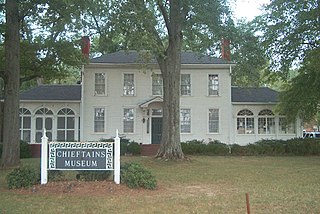
Chieftains Museum, also known as the Major Ridge Home, is a two-story white frame house built around a log house of 1792 in Cherokee country. It was the home of the Cherokee leader Major Ridge. He was notable for his role in negotiating and signing the Treaty of New Echota of 1835, which ceded the remainder of Cherokee lands in the Southeast to the United States. He was part of a minority group known as the Treaty Party, who believed that relocation was inevitable and wanted to negotiate the best deal with the United States for their people.
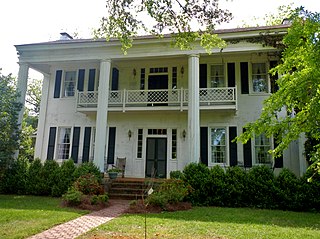
Liberty Hill in La Grange, Georgia, about 0.75 miles (1.21 km) west of the Chattahoochee River in Troup County, is a Greek Revival style plantation house built in the 1830s or 1840s. The original cotton plantation owner, John T. Boykin, bought the piece of land the house is on in 1836. The house with its current 150 acres (61 ha) property, was listed on the National Register of Historic Places in 1975.
The Singleton House near Eatonton, Georgia was listed on the National Register of Historic Places in 1974. It is located southwest of Eatonton, off Georgia Route 16. More specifically, it is about seven miles west of Eatonton, then one mile south of the intersection of Highway 16 and Georgia Highway 142, on the right fork of a what was a dirt road in 1974. In 2018, it may be located off what is now named McMillen Road, and may be the structure at exactly 33.297786°N 83.493705°W.

Fort Morris Historic Site is a Georgia state historic park in Liberty County, Georgia in the United States. The fort is on a bend in the Medway River and played an important role in the protection of southeast Georgia throughout various conflicts beginning in 1741 and ending in 1865 at the conclusion of the American Civil War, including the French and Indian and American Revolutionary Wars and War of 1812. The historic site is 70 acres (28 ha) and sits at an elevation of 23 feet (7.0 m).

Susina Plantation is an antebellum Greek Revival house and several dependencies on 140 acres near Beachton, Georgia, approximately 15 miles (24 km) southwest of the city of Thomasville, Georgia. It was originally called Cedar Grove. The house is listed on the National Register of Historic Places, and is currently a private residence.

John Wind was an architect who worked in southwest Georgia in the United States from approximately 1838 until his death in 1863. He was born in Bristol, England, in 1819. John Wind designed the Greenwood, Susina, Oak Lawn, Pebble Hill, Eudora and Fair Oaks monumental plantation houses, the Thomas county courthouse and a few in-town cottages. William Warren Rogers writes "Some of Wind's work still exists and reveals him as one of the South's most talented but, unfortunately, least known architects." John Wind also worked as an inventor, jeweler, master mechanic and surveyor. He devised a clock that remained wound for one year and was awarded a patent for a cotton thresher and cleaner, Patent Number 5369. He was also the co-recipient of a corn husker and sheller patent in 1860. But it was his work as an architect that made him an enduring figure.
Windsor Plantation is a historic house on Russell Creek on Edisto Island, South Carolina.
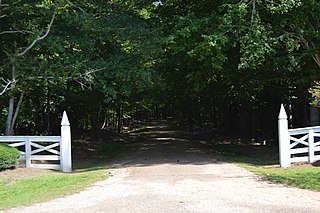
Hesse is a historic plantation house located near Blakes, Mathews County, Virginia. It was built about 1725, and is a five-bay, two-story Georgian style brick dwelling. It has a single-pile plan and is topped by a gable roof. A modern five-bay flanking south wing was built in 1952.
The A. Landi General Merchandise Building is a historic commercial building on Arkansas Highway 8 near Eudora, Arkansas in the village of Grand Lake. Built c. 1920, it is a single story wood-frame building with Plain Traditional styling, including a central section on its main facade with a raised parapet section over the centered entrance. The building is significant for its association with the Landi family, one of a small number of Italian immigrants to remain in the area after the plantation economy collapsed.
Brown–Graves House and Brown's Store is a historic plantation complex located near Locust Hill, Caswell County, North Carolina. The plantation house was built about 1800, and is a two-story, five bay, Late Georgian style frame dwelling. It is set on a stone basement and has a low hipped roof. The front facade features a one-story pedimented porch with Corinthian order columns. Brown's Store is located across from the house and is a one-story, gabled frame building with a single shouldered stone and brick chimney. Also on the property are the contributing two slave quarters, a smoke house, and a Greek Revival period law office.

Mowfield is a historic plantation house located near Jackson, Northampton County, North Carolina. It was built about 1802, and is a two-story, five bay by two bay, Georgian / Federal style frame house with a two-story ell. Each section is covered by a hipped roof. It features a two-tier full-width porch, engaged under the high hip roof of the house. Also on the property is a contributing outbuilding. Mowfield Plantation was the home of Sir Archy, one of the greatest thoroughbred sires of the 19th century, where he was at stud from 1816 until his death in 1833.

The Hofwyl-Broadfield Plantation was a plantation on the Altamaha River, in Glynn County, Georgia. Operated as a forced-labor farm until 1865, it produced rice from 1800 until 1915, when growing rice became unprofitable. Then it was primarily a dairy farm until 1942.
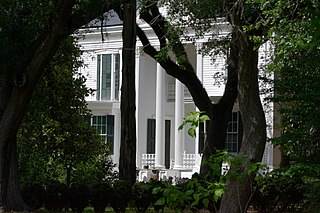
Birdsville Plantation, in Birdsville, Jenkins County, Georgia near Millen, is a 50 acres (20 ha) property which was listed on the National Register of Historic Places in 1971. It then included 10 contributing buildings. It is a National Bicentennial Farm.
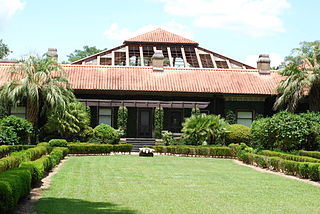
The Millpond Plantation in Thomas County, Georgia near Thomasville was listed on the National Register of Historic Places in 1976.
The Toney-Standley House in or near Fort Gaines, Georgia, United States, was built in c.1810. It was listed on the National Register of Historic Places in 1974. It has also been known as Col. William Toney House.
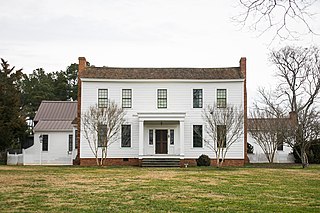
The Zachry-Kingston House, in Morgan County, Georgia, near Buckhead, was built in 1830. It was listed on the National Register of Historic Places in 1987.

The Terrell-Sadler House near Eatonton, Georgia was listed on the National Register of Historic Places in 2000. It is located at 122 Harmony Road.














